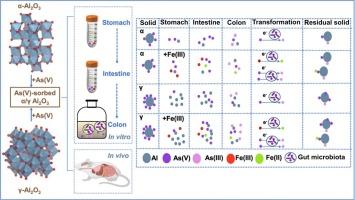Arsenic bioavailability and transformation from As(V)-sorbed aluminum oxides: The influence of Fe(III) and human gut microbiota
IF 11.3
1区 环境科学与生态学
Q1 ENGINEERING, ENVIRONMENTAL
引用次数: 0
Abstract
Minerals control on the oral bioavailability of arsenic (As) in soil has been evidenced in human health risk assessments. However, little is known about the metabolism of soil mineral-associated As by human gut microbiota. This study evaluated the relative bioavailability (RBA) and bioaccessibility of As in As(V)-sorbed Aluminum (Al) oxides (α-Al2O3 and γ-Al2O3), affected by gut microbiota and Fe(III). The in vitro method yielded higher As bioaccessibility in the small intestinal phase of α-Al2O3 (30.3 %–54.8 %) and in the colon phase of γ-Al2O3 (29.7 %–45.6 %), respectively. In the presence of Fe, As release was decreased by14.5 %–48.1 % in the small intestine but increased by 37.5 %–86.3 % in the colon (p < 0.05). Speciation analysis revealed that gut microbiota reduced nearly half of the As(V) to As(III) in the colon digests, with up to 21.0 % of As(III) remaining in the solid phase. More than 92.0 % of Fe(III) in the colon digests was reduced to Fe(II), which would facilitate As reduction but inhibit methylation. A mouse bioassay was conducted to estimate As-RBA (21.3 %–58.8 %) in Al oxides, decreased by Fe(III) addition under high As exposure. Our findings provide new insights into the role of Al oxides in the risk assessment from inadvertent oral ingestion of As-contaminated soils.

砷的生物利用度和As(V)吸附氧化铝的转化:铁(III)和人体肠道微生物群的影响
矿物质对土壤中砷的口服生物利用度的控制已在人类健康风险评估中得到证实。然而,人类肠道菌群对土壤矿物质相关砷的代谢知之甚少。本研究评估了As(V)吸附铝(Al)氧化物(α-Al2O3和γ-Al2O3)中As的相对生物利用度(RBA)和生物可及性,并对其受肠道菌群和Fe(III)的影响进行了评价。体外法α-Al2O3在小肠期(30.3% ~ 54.8%)和γ-Al2O3在结肠期(29.7% ~ 45.6%)的As生物可及性较高。在Fe存在下,As在小肠中的释放量减少14.5% ~ 48.1%,而在结肠中的释放量增加37.5% ~ 86.3% (p <;0.05)。物种分析显示,肠道微生物群将结肠消化中近一半的As(V)减少到As(III),其中高达21.0%的As(III)保留在固相中。结肠消化中超过92.0%的Fe(III)被还原为Fe(II),有利于As的还原,但抑制了甲基化。用小鼠生物测定法测定了高砷暴露条件下,添加铁(III)降低的铝氧化物中As- rba(21.3% ~ 58.8%)。我们的研究结果为Al氧化物在无意中口服砷污染土壤的风险评估中的作用提供了新的见解。
本文章由计算机程序翻译,如有差异,请以英文原文为准。
求助全文
约1分钟内获得全文
求助全文
来源期刊

Journal of Hazardous Materials
工程技术-工程:环境
CiteScore
25.40
自引率
5.90%
发文量
3059
审稿时长
58 days
期刊介绍:
The Journal of Hazardous Materials serves as a global platform for promoting cutting-edge research in the field of Environmental Science and Engineering. Our publication features a wide range of articles, including full-length research papers, review articles, and perspectives, with the aim of enhancing our understanding of the dangers and risks associated with various materials concerning public health and the environment. It is important to note that the term "environmental contaminants" refers specifically to substances that pose hazardous effects through contamination, while excluding those that do not have such impacts on the environment or human health. Moreover, we emphasize the distinction between wastes and hazardous materials in order to provide further clarity on the scope of the journal. We have a keen interest in exploring specific compounds and microbial agents that have adverse effects on the environment.
 求助内容:
求助内容: 应助结果提醒方式:
应助结果提醒方式:


